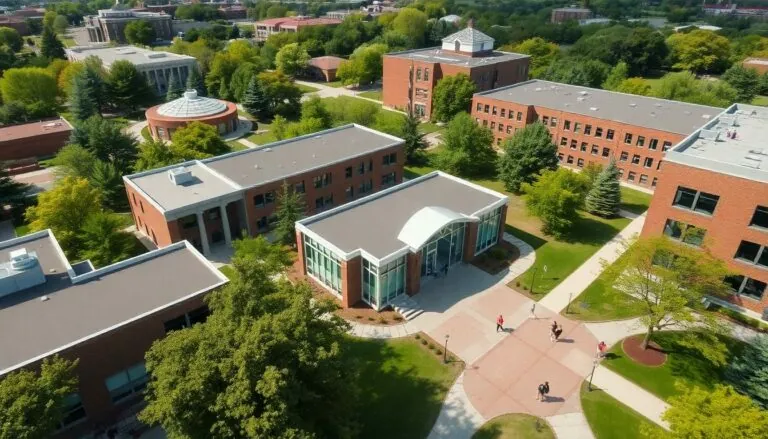Table of Contents
ToggleNavigating the world of college tuition can feel like trying to solve a Rubik’s Cube blindfolded. Hiram College, nestled in the heart of Ohio, offers an educational experience that’s hard to beat, but the question on everyone’s mind is: how much will it cost? Spoiler alert: it’s not as scary as it sounds, and there are plenty of options to keep your wallet happy.
Overview of Hiram College Tuition
Hiram College offers a competitive tuition structure designed to provide quality education while remaining accessible. For the 2023-2024 academic year, undergraduate tuition is set at approximately $37,500 per year. Students should account for additional fees, which typically include technology and activity fees, increasing the overall cost.
Financial aid opportunities significantly impact tuition affordability at Hiram. About 99% of students receive financial aid, which includes grants, scholarships, and loans. The average financial aid package awards roughly $29,000, effectively reducing the net tuition cost for many students.
Various scholarships are available to incoming freshmen, including academic merit and need-based options. These scholarships can range from $10,000 to $20,000 annually, enhancing affordability further. Additionally, students can explore work-study programs to gain practical experience while earning funds to help cover educational expenses.
Living expenses also factor into overall tuition costs. On-campus housing fees vary based on the type of accommodation selected, with an approximate range of $6,500 to $10,500 per year. Dining plans add another layer, typically costing about $3,000 annually.
Hiram College emphasizes transparency in tuition costs. The college provides a detailed breakdown of expenses to aid families in financial planning. With various financial support options and an emphasis on affordability, Hiram College strives to make higher education attainable for all students.
Tuition Costs
Hiram College offers a competitive tuition structure designed to make higher education more accessible. Understanding the various rates is essential for effective financial planning.
Undergraduate Tuition Rates
Undergraduate tuition for the 2023-2024 academic year is approximately $37,500 annually, excluding additional fees. Students interested in financial assistance benefit significantly, as about 99% receive aid, averaging around $29,000 per package. Incoming freshmen can apply for scholarships that range from $10,000 to $20,000 yearly, enhancing affordability. Additional charges for materials and other fees may apply, so comprehensive planning is advisable.
Graduate Tuition Rates
Graduate tuition rates start at approximately $13,500 per year, varying by program. Hiram College provides various financial aid packages for graduate students, helping to offset education costs. Scholarships and assistantships can also offer financial relief, reducing tuition expenses further. It’s important for prospective students to consult the specific program details to understand the complete financial commitment involved.
Financial Aid Opportunities
Hiram College provides multiple financial aid options to ease tuition expenses. Various programs cater to different student needs, ensuring that education remains accessible.
Scholarships and Grants
Scholarships at Hiram College significantly reduce financial burdens. Incoming freshmen can receive scholarships ranging from $10,000 to $20,000 annually. About 99% of students benefit from financial aid, enhancing affordability. Grant opportunities further supplement this support, providing additional financial resources to those who qualify. Students should explore both merit-based and need-based scholarships to maximize their financial assistance.
Loans and Work-Study Programs
Hiram College offers loan options designed to help students manage tuition fees. Federal student loans provide a strong foundation for funding education. A work-study program allows students to earn money while studying, which helps cover living expenses and tuition. Many students benefit from part-time employment opportunities on campus, making education more financially manageable. Students are encouraged to apply for loans and work-study positions, ensuring comprehensive financial plans.
Comparison with Other Institutions
Hiram College’s undergraduate tuition of approximately $37,500 annually ranks competitively among similar institutions in Ohio. In comparison, nearby colleges like Baldwin Wallace University charge about $31,512, while Ohio Wesleyan University lists tuition around $53,610. Graduate tuition at Hiram starts at $13,500 per year and varies by program, which is significantly lower than the $15,000 to $40,000 range typical at other nearby universities.
Financial aid is a critical factor in assessing affordability. Around 99% of Hiram students receive aid, averaging about $29,000 each. In contrast, at Ohio University’s average aid package sits around $17,000, while Kent State University provides about $15,800. Scholarship opportunities at Hiram for incoming freshmen range from $10,000 to $20,000 annually, exceeding typical awards at other institutions.
Living expenses significantly impact overall costs. Hiram’s on-campus housing and dining plans contribute to the total expense, with the national average for college living expenses approximately $14,000 per year. Other institutions, such as Denison University, report higher living costs, averaging $16,450.
Hiram ensures transparency in tuition and fees, offering detailed breakdowns that facilitate financial planning for families. A comprehensive understanding of each institution’s cost structure aids students and families in making informed choices. Graduate students at Hiram also benefit from various financial aid packages, including scholarships and assistantships, which are on par with those offered at peer institutions.
Student Experiences and Testimonials
Students at Hiram College frequently express satisfaction with their financial aid packages. Many highlight that approximately 99% of their peers receive financial assistance, averaging around $29,000. Such support significantly eases the burden of tuition costs.
Incoming freshmen often report receiving scholarships ranging from $10,000 to $20,000 annually, fostering a sense of appreciation for the college’s commitment to affordability. Graduates also benefit from diverse financial aid options, including scholarships and assistantships, that align well with their academic aspirations.
Feedback from students indicates that Hiram’s tuition structure remains competitive. Comparisons with other Ohio colleges, like Baldwin Wallace University and Ohio Wesleyan University, show Hiram’s tuition of around $37,500 stands out as more affordable.
Living expenses at Hiram also receive mention as part of the overall college experience. The average annual cost for housing and dining is noted to run about $14,000, which aligns with national averages, so students feel informed about their total financial commitments.
Alumni testimonials often focus on the transparency in Hiram College’s tuition and fees. Detailed expense breakdowns help families plan effectively, contributing to a more stress-free college experience.
Overall, students and alumni value the affordability of Hiram College’s education and the myriad opportunities made available through financial aid. These testimonials underline the institution’s dedication to making higher education accessible for all students.
Conclusion
Hiram College stands out as an affordable option for higher education in Ohio. With a commitment to transparency and a variety of financial aid opportunities, it effectively supports students in managing tuition costs. The competitive tuition rates and generous scholarship offerings make it an attractive choice for both undergraduate and graduate students. As families navigate the complexities of college expenses, Hiram’s dedication to accessibility ensures that a quality education remains within reach for many. The positive feedback from students and alumni further reinforces the college’s reputation as a supportive and financially mindful institution.








